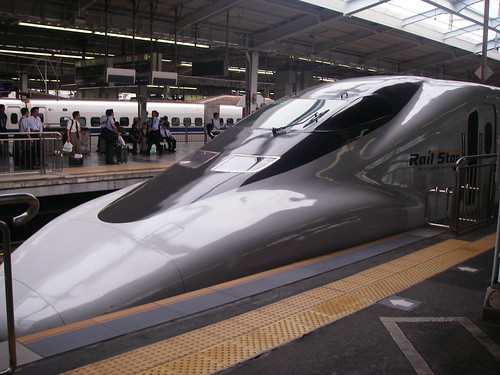Time-Warps
06/09/2007
International ATMs are a recent arrival in Japan—unsurprisingly for an island nation where most inhabitants have local bank accounts. I’d decided to play it safe and rely on good old-fashioned cash instead.
So, my first port of call was the post office, where I ended up in a time-warp into the last century. As I took a number in front of the foreign exchange counter, a woman approached and pressed an actual form into my hand. Passport number and all.
I filled it in. Then I played the waiting game, trying to aim for that zen-like calm which is the only way to deal with queues in post offices. Or worse: deserted foreign exchange counters and long queues everywhere else in the post office.
My turn came at last, and I handed over my money, realising that I might be in for a longer wait still. England has recently changed the look of its 20 pound note, and the new note looks like toy money. It didn’t help that the cash machine at Heathrow spat out four old-style twenties and six new ones, so that it looked like I carried a stash of mixed currencies. I expected to receive the same treatment as I get in London when showing up with Scottish sterling: “we don’t take Monopoly money here, mate!”
However, this wasn’t London. The service at the post office—here and everywhere— may be glacially slow (I think the trainee who served me had a minimum of three supervisors looking over her shoulders at all times) but it is unthinkable that an honourable customer whould attempt to defraud the honourable postal service.
So my money was accepted with a smile and the lady retreated behind some desks where I could see her and her three supervisors pore over a booklet with various denominations depicted in it. Chances are that the brand-new twenties aren’t in it. After mere twenty minutes or so of whispered debate, she turned back to the counter where she smiled and bowed and presented me with the exact change on a little wooden tray.
I bit down my irritation, smiled in turn and bowed. Chores completed, I was finally free. And it was still one hour until my train would arrive (yes, I had made a reservation. I didn’t know better—it was only my second time on the Shinkansen).

I wasn’t sure whether today was going to be a good day or a bad day. I find that, when travelling, the two seem to alternate, and yesterday had been good—at least until I’d made the decision to go to Hiroshima and discovered that all the hostels were fully booked, and should ideally be booked three days in advance.
Whatever the case, I was determined to make the most of what the day threw at me.
The wait meant that there was enough time for breakfast. The main food places (which line an entire side-lane in Kyoto’s large underground shopping area) were just about to open. I wanted something savoury and light, so I made an impromptu decision to pick a set built around what looked like bean stew with quail’s eggs.
It’s never as simple as pointing at the window display: there was a choice of onigiri to go with the set. The poor waitress struggled with her dozen words of English while I berated myself for not being able to understand anything she said, not even the simplest sentence, despite listening to audio and making extensive notes about grammar and expressions.
I was so embarrassed that I could barely swallow the onigiri, which was dry and cloying. And—with the eyes of all the waiting staff on me in the still near-deserted restaurant—I knew that I wouldn’t be able to eat the main dish, which of course wasn’t bean stew.
It wasn’t actually bad, I just felt weirded out.
Things looked up on the Shinkansen. This time, I found the smokers’ carriage.

Today was the day that old and new would continue to collide: twen-cen anachronisms interwoven with near future reality. It’s not that the Shinkansen are new—the first Hikari started running in the year I was born—but they feel futuristic, especially since Britain is actually regressing back in time. I expect the reintroduction of steam locomotives and horse-drawn trams there any day now.
By contrast, I don’t think I ever get used to the speed of the Shinkansen. It wouldn’t surprise me in the least if the thing lifted off at any moment. In fact, on my first train journey I caught myself thinking they have damn long runways in Japan.
The smoking carriage is, of course, another anachronism, but a nice one. So are manners: you may think it’s a big deal to bow when entering and leaving the dojo—the conductors do it when entering and leaving every carriage
The train got me from Ōsaka to Hiroshima in just over ninety minutes. As the landscape whisked past, I began to wonder whether they’d have a peace camp there. I had brought my tent.
When the train zoomed into a station, I spotted Himeji Castle through a gap in the high-rises. Here’s the thing: these trains are built for speed, not for sight seeing. But outside the holiday season, there are plenty of seats. I could hop off and stop over wherever I like. And all the stations have coin lockers. Another anachronism.
I think I’m getting the hang of travelling Japan on a rail pass—just when I’m about to run out of time.
Tags: Hiroshima, Japan without a Clue, Peace, Shinkansen, Travel, Tag Index